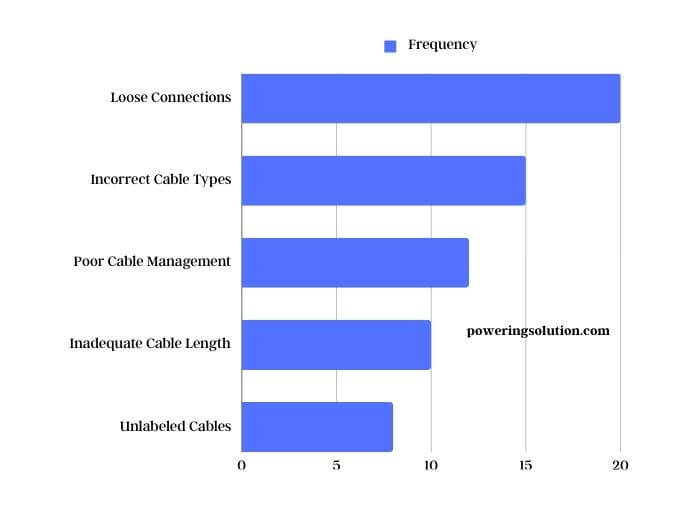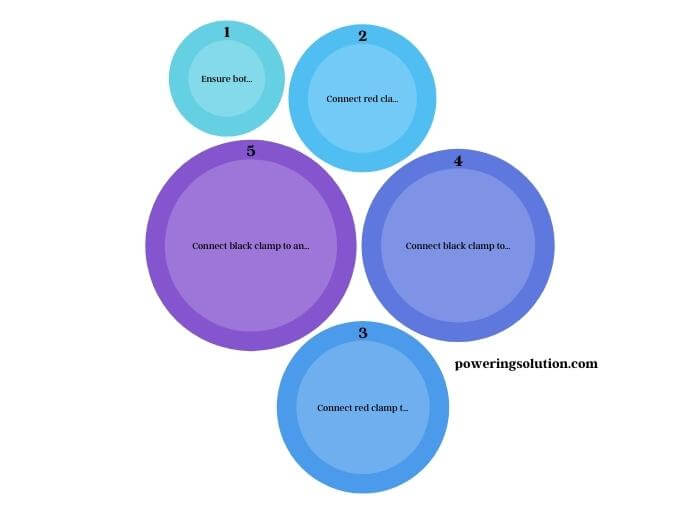Jumper cables smoking when connected is a sign of a serious issue. It indicates a problem either with the cables or the way they are being used.
When jumper cables smoke or even melt, it’s often due to incorrect usage or a fault in the cables themselves. This can happen if the cables are not properly connected to the correct terminals of the battery. Connecting the positive and negative terminals incorrectly can cause sparking and potentially lead to cables smoking or melting. It’s crucial to ensure that the red clamp is connected to the positive terminal and the black clamp to the negative terminal of both batteries.
Another reason for jumper cables smoking could be the use of cables that are not suitable for the vehicle’s requirements. Thinner cables, for instance, might not be able to handle the electrical load, leading to overheating and smoking. In cases where jumper cables have melted, it’s generally advised not to reuse them as their integrity is compromised, which could lead to dangerous situations.

Understanding how to jump-start a car correctly is essential for safety. The process involves connecting the cables in the right order and starting the working car first before the one with the dead battery. Videos and social media posts, like those on TikTok, often show dramatic instances of jumper cables melting, highlighting the risks of incorrect usage.
For those interested in learning the correct way to use jumper cables and avoiding hazards like smoking or melting cables, a detailed article is available below. This guide provides step-by-step instructions and safety tips for jump-starting a car effectively and safely.
Jumper Cables Smoking When Connected – Causes and Solutions
The Dangers of Smoking Jumper Cables
Understanding the Risks
When jumper cables start smoking, it’s a clear sign that something’s gone wrong, and it’s not something to take lightly. This smoking can be a precursor to fires, damage to both vehicles involved, and even serious injuries. It’s crucial to recognize that jumper cables are not just simple tools; they carry a significant amount of electrical current. When they malfunction, the risks are real. From minor sparks to major fires, the consequences can range widely. It’s all about being aware and prepared to handle these situations safely.
Case Studies of Accidents and Injuries
Over the years, there have been numerous instances where improper use of jumper cables led to accidents and injuries. For instance, a case study might detail an incident where a person suffered burns due to a cable catching fire. These real-life examples serve as stark reminders of the potential dangers. They highlight the need for proper knowledge and caution when using jumper cables. Each incident teaches us valuable lessons about safety and the correct handling of these tools.
Identifying the Causes of Smoking Jumper Cables
Incorrect Connection and Its Consequences
One of the primary reasons jumper cables smoke is incorrect connection. This usually happens when the positive and negative clamps are mixed up. Connecting the positive clamp to the negative terminal and vice versa creates a short circuit, leading to overheating and smoking. This mistake can damage the electrical systems of both cars involved and even cause the battery to explode in extreme cases. It’s a simple error with potentially catastrophic consequences.
Common Mistakes in Cable Connection
| Mistake | Consequence |
| Reversing clamps | Short circuit, potential battery damage |
| Partial connection | Sparks, inefficient charging |
| Using damaged cables | Overheating, potential fire hazard |

Inadequate Cable Quality and Specifications
Not all jumper cables are created equal. Using cables that are too thin or made from low-quality materials can lead to them overheating and smoking. The gauge of the cable is crucial; the lower the gauge number, the thicker the cable and the more current it can safely handle. Using cables that aren’t up to the task for your vehicle’s needs is like trying to drink a milkshake through a cocktail straw – it just doesn’t work well and can cause problems.
Environmental Factors and Their Impact
Environmental factors like extreme temperatures can also play a role in jumper cables smoking. In very cold weather, cables can become stiff and less efficient, while in hot conditions, they might overheat more easily. It’s important to consider these factors, especially when you’re in a situation where you need to jump-start a car in less-than-ideal conditions.
Safety First: Preventive Measures and Best Practices
Step-by-Step Guide to Safely Connect Jumper Cables
Let’s talk about how to connect jumper cables the right way. First, make sure both cars are turned off. Connect the red clamp to the positive terminal of the dead battery, then do the same on the good battery. Next, connect the black clamp to the negative terminal of the good battery. Finally, attach the other black clamp to an unpainted metal surface on the car with the dead battery. This step-by-step process ensures a safe and effective jump-start.
Safety Checklist for Jump-Starting a Vehicle
| Step | Action |
| 1 | Ensure both cars are off |
| 2 | Connect red clamp to dead battery’s positive terminal |
| 3 | Connect red clamp to good battery’s positive terminal |
| 4 | Connect black clamp to good battery’s negative terminal |
| 5 | Connect black clamp to an unpainted metal surface on the dead battery’s car |

Personal Protective Equipment (PPE) for Jump-Starting
Safety gear is key. Always wear protective gloves and safety glasses when jump-starting a car. This protects you from sparks and potential battery acid. It’s a simple step that can prevent a lot of harm.
Troubleshooting Jumper Cable Issues
Signs of Faulty Jumper Cables
If you notice any fraying, cracks, or exposed wires on your jumper cables, it’s time to replace them. These are clear signs that the cables are compromised and could lead to dangerous situations like smoking or even fires. Also, if the clamps don’t grip well or seem loose, that’s another red flag. Faulty equipment is not just ineffective; it’s hazardous.
Diagnosing Problems with Car Batteries
Sometimes, the issue isn’t with the cables but with the battery itself. If a battery is old, leaking, or shows signs of significant corrosion, it might not be safe to jump-start. In these cases, it’s better to seek professional help rather than risking a jump-start with potentially smoking cables.
Troubleshooting Guide for Jumper Cable Problems
| Problem | Solution |
| Frayed cables | Replace with new ones |
| Weak clamp grip | Check for clamp damage, replace if necessary |
| Overheating cables | Ensure correct gauge for vehicle, replace if inadequate |

Proper Usage of Jumper Cables
Selecting the Right Jumper Cables for Your Vehicle
Choosing the right jumper cables is like picking the right tool for a job. You need cables that match your vehicle’s requirements. Generally, a gauge of 6 or lower is suitable for most passenger vehicles. Trucks and larger vehicles might need even thicker cables. The length is also important; longer cables offer more flexibility but can lose power over distance, so balance is key.
Detailed Steps to Jump-Start a Car
Jump-starting a car is not just about connecting cables; it’s about doing it in the right order and method. After connecting the cables as described earlier, start the engine of the working car first. Let it run for a few minutes to charge the dead battery. Then, try starting the car with the dead battery. If it starts, let it run for a while before disconnecting the cables in the reverse order of how you connected them.
Tips to Avoid Common Mistakes
Always make sure the cars are not touching each other and that the cables are not tangled. Never connect both black clamps to the batteries. And remember, if you’re ever in doubt, it’s better to consult the vehicle’s manual or seek professional help rather than guessing.
Maintenance and Care of Jumper Cables
Routine Inspection and Maintenance Tips
Regularly inspect your jumper cables for any signs of wear and tear. Look for cracks, rust, and damage to the insulation. Keep the clamps clean and free from corrosion. Proper maintenance extends the life of your cables and ensures they’re ready when you need them.
Storing Jumper Cables Correctly
Store your jumper cables in a dry, cool place. Avoid excessive heat or moisture, as these can damage the cables over time. Many cables come with a bag or case – use it. It protects the cables and keeps them organized.
When to Replace Jumper Cables
If you notice any damage or if the cables have been through a particularly tough jump-start, it might be time to replace them. It’s better to invest in a new set of cables than to risk using ones that might fail when you need them most.
Could Smoking Jumper Cables Cause a Jeep to Not Start Even with a Good Battery?
Yes, smoking jumper cables could cause a jeep to not start even with a good battery. It could indicate a short circuit in the electrical system, causing damage to the starter or other components. If you’re experiencing issues, it’s important to follow jeep starting troubleshooting tips to diagnose the problem.
Learning from Real-Life Incidents
Analysis of Social Media Videos (TikTok, YouTube)
Social media is full of videos showing jumper cable mishaps. While they can be dramatic, they’re also educational. Analyzing these videos helps us see what can go wrong and how to avoid similar mistakes. They’re real-world examples of the importance of proper jumper cable use.
Lessons Learned from Jumper Cable Mishaps
Every incident where jumper cables smoke or cause a problem is a learning opportunity. These situations teach us about the importance of following the right steps, using quality equipment, and respecting the power of these tools. They remind us that safety should always be our top priority.
In this article, we’ve covered the ins and outs of jumper cables, from the dangers of smoking cables to the best practices for safe and effective use. We’ve looked at how to choose the right cables, how to use them correctly, and how to maintain them. We’ve also learned from real-life incidents and understood the importance of safety gear. Remember, jumper cables are powerful tools, and with great power comes great responsibility. Stay safe and be prepared!
